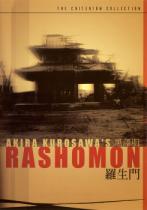Rashômon
 Year:
Year: 1950
Film Studio: Daiei Studios
Genre: Drama, Classic
Length: 88 Min.
Director Akira Kurosawa (1910)
Writer Akira Kurosawa (1910)...Writer
Shinobu Hashimoto (1918)...Writer
Producer Minoru Jingo
Masaichi Nagata (1906)
Cinematographer Kazuo Miyagawa (1908)
Music Fumio Hayasaka (1914)...Composer
StarsToshirô Mifune (1920) as Tajômaru
Machiko Kyô (1924) as Masako Kanazawa
Masayuki Mori (1911) as Takehiro Kanazawa
Takashi Shimura (1905) as Woodcutter
Minoru Chiaki (1917) as Priest
Kichijirô Ueda (1904) as Commoner
Noriko Honma (1910) as Medium
Daisuke Katô (1910) as Policeman
Review On a sleepy and sultry summer day, a samurai (Masayuki Mori) and his beautiful wife (Machiko Kyô) are traveling down a long road in the forest when they chance upon a stranger resting beneath a tree on the side of the road. At first, the samurai is apprehensive about the look of this stranger, is he a peasant, a vagrant or a bandit? As they pass, the samurai slowly sets his fears aside and continues on his journey. Unbeknownst to the samurai, is that the stranger he has just left in his wake, is the famous bandit Tajômaru (Toshirô Mifune). Soon the samurai will pay with his life for not heeding his instinctive anxiety a few moments earlier. What follows is a crime drama that bases its storyline on the divergent paths that all three of the protagonists have come to believe is the truth about what actually happened on that lazy summer day.
When it was first released in 1950, the screenplay for
Rashômon was considered groundbreaking. The formula of the day for crime drama’s and mysteries was simple; good-vs.-evil. Yet
Rashômon would discard this convention outright by portraying all of the principle characters as flawed and perverse pawns in a game of pride and ego enhancement. Yes a murder has taken place, or was it suicide in defense of the samurai’s honor? As the local crime officials conduct their investigation, we are given insight into the difficulty that law enforcement has to deal with in so-called eyewitness testimony.
First we hear from the accused killer Tajômaru, who states that he only wanted to have the woman for himself and planned to take her without killing the husband. But after he seduces the woman, she begs him to kill the husband. Tajômaru slays the husband in the hopes of claiming the woman for his own. But while he is dealing with the dastardly deed of eliminating the man, the wife escapes.
Next we hear from the wife who declares that she was raped by Tajômaru in plain sight of her bound husband. When Tajômaru has finished assaulting her, he takes the samurai’s valuables and leaves. When the wife approaches her husband, he views her as an evil seductress who brought about the shame that was visited upon her by Tajômaru. The shock and horror of his icy stare are too much for the woman to bear and in a moment of irrationality she plunges her dagger into his chest.
Finally, through the help of a spirit medium, from beyond the grave we hear the samurai’s account of the tale. In his version of events, he was bound by the bandit and forced to watch his wife being raped. After Tajômaru is finished with the assault he convinces her that he truly loves her and that is what forced his actions. The wife then asks Tajômaru to kill her husband so that she can be with the bandit. The thought of such a betrayal is even surprising to Tajômaru and he offers to kill the woman who has just disgraced her husband. When Tajômaru moves forward towards the man, the wife runs off with Tajômaru in close pursuit. Hours later, the bandit returns and frees the samurai, but the shame is unbearable and having been raised in the full measure of the bushido doctrine, he commits hara-kiri.
Just when it looks like the crime will never be solved, a fourth witness gives testimony to the true events that transpired that afternoon. A local woodchopper who had been out gathering fuel for the evening’s fire had come upon the three protagonists and had secretly witnessed the actual crime. Because he holds no connection to any of the principles involved, it is his version that proves to be the accurate account. Naturally, I won’t go any further in the story for fear of giving away the final ending, but I’ll suffice it to say, that the woodchopper’s recounting of events actually weaves a little bit of all three stories that we heard throughout the film.
To a modern day audience, the premise for this film may not seem original, but in 1950 this screenplay was completely innovative. It would cast the careers of both the director Akira Kurosawa, and its star Toshirô Mifune, onto the world film stage. So powerful would be its effect on future directors that endless shallow copies of this formula have been made in the last five decades around the globe. Its premise of conflicting eyewitness testimony has lent itself to become part of the lexicon of the crime investigation field. When law enforcement is gathering the evidence and accounts of a crime from supposed eyewitnesses and varied versions of the events are being alleged, it is now proclaimed
‘the Rashômon effect’.
Ratings Criterion5 Stars - The pinnacle of film perfection and excellence.
4 ½ Stars - Not quite an immortal film, yet a masterpiece in its own right.4 Stars - Historically important film, considered a classic.
3 ½ Stars - An entertaining film that’s fun or engaging to watch.
3 Stars – A good film that’s worth a Netflix venture.
2 ½ Stars - Borderline viewable.
2 Stars – A bad film that may have a moment of interest.
1 ½ Stars – Insipid, trite and sophomoric, and that's its good points.
1 Star – A film so vacuous, it will suck 2 hours from the remainder of your life.
½ Star - A gangrenous and festering pustule in the chronicles of celluloid.